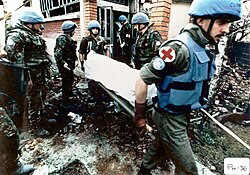



Operation Grapple was the codeword used to cover UK defence operations in support of the UN peacekeeping missions in the former Yugoslavia (authorised by UNSCR 776 of September 1992); [1] including the deployment of British forces in Bosnia and Croatia from October 1992 until December 1995 as part of the United Nations Protection Force (UNPROFOR). [2] [3] UNPROFOR would eventually hand over the peacekeeping mission in Bosnia to NATO's Implementation Force (IFOR) in winter 1995. The British participation in the IFOR was called Operation Resolute; the whole NATO mission was called Operation Joint Endeavour. The IFOR mission would last approximately a year, before it transitioned to the follow-on Stabilisation Force in Bosnia and Herzegovina (SFOR).
Contents
The United Kingdom originally deployed a compact army headquarters staff (commanded by a brigadier) - based in a former Yugoslav People's Army (JNA) barracks at Divulje near Split. [4] The force was supervised by the Army's Land Command at Wilton in Wiltshire. The main manoeuvre forces were an infantry battle group (based in Bosnia); supported by an armoured reconnaissance squadron, a combat engineer squadron and a logistics support unit. A detachment of Fleet Air Arm Sea King troop carrying helicopters was also based in Divulje barracks (found from 845 and 846 Naval Air Squadrons). Some of the British unit locations were very isolated with only small amounts of security such as the Royal Engineers base at Camp Redoubt [5] on a particularly hilly part of the main supply route to Vitez [6] and 7 Armoured Workshop Company Royal Electrical and Mechanical Engineers in Gornji Vakuf-Uskoplje providing Second Line Equipment Support (ES), the British contribution to UNPROFOR also included the deployment of Royal Navy ships sailing in the Adriatic Sea and RAF aircraft supporting troop movements in Croatia. Two Royal Fleet Auxiliary ships were also berthed in Split's north port to provide accommodation and logistics support. This force would be increased in size over the course of the UN peacekeeping mandate in the Former Yugoslavia up until August 1995 when the British force was steadily drawn down. [7] [8]
The UK agreed to join the UN force to protect humanitarian convoys in Bosnia, as part of UNPROFOR 2. In early October 1992, 7 Armoured Workshop Company Royal Electrical and Mechanical Engineers arrived to set up the in-theatre Second Line Equipment Support (ES) and to provide the Recovery and Repair along the L of C. The (BRITBAT) the Cheshire Regiment which deployed with its Warrior tracked armoured vehicle in late October 1992 through the Croatian port of Split, eventually headquartering itself in a school on the outskirts of the town of Vitez in the Lašva Valley. The battalion would have operating bases in Gornji Vakuf and Tuzla; and there was also a British logistics base at Tomislavgrad. [9] The British contingent was expanded with the addition of another battalion group in March 1994. [10] [11]
The first BRITBAT's time in Bosnia was not without controversy and its commanding officer Lieutenant Colonel Bob Stewart very publicly lost his composure and impartiality after his unit discovered the remains of Muslim civilians who had been massacred by Croats in the village of Ahmići in April 1993. [12]
British units took casualties from the outset and Lance Corporal Wayne Edwards, a Warrior tracked armoured vehicle driver, was shot and killed by a sniper, whilst driving his vehicle in Gornji Vakuf on 13 January 1993. Others would also sadly lose their lives; such as Private Shaun Taylor mortally wounded on 26 June 1994 near Goražde. [13] British armed forces would serve nearly 15 years in Bosnia and would see more than 50 comrades killed and many more wounded. [14] Many of the casualties were as a result of Bosnia and Croatia's appalling road and weather conditions. [15]
BRITBAT and its supporting sub-units would win praise by becoming the guardians of the only functioning main supply route into the core of Bosnia and ultimately Sarajevo and Tuzla, [16] the maintenance of Routes Triangle and Diamond would remain a critical combat engineering task.